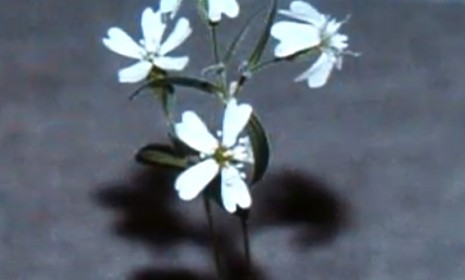How scientists resurrected a 30,000-year-old flower
After successfully growing samples of an ancient flower, scientists dream of applying the same technique to the re-creation of a woolly mammoth

A few years ago in northeastern Siberia, Russian scientists uncovered a rare trove of immaculately frozen Arctic squirrel burrows dating back to the Ice Age. Inside they found buried seeds, including the fruit of a flower called the narrow-leafed campion. Now, after 30,000 years, they've brought the original flower back to life. Here's what you should know:
Did they grow the flower from frozen seeds?
Not exactly. Efforts to resurrect ancient plants from seeds found "wonderfully preserved by the cold, dry environment" fell short, says Sharon Levy at Scientific American, including attempts to sprout sedge, alpine bearberry, and the narrow-leafed campion (known scientifically as Silene stenophylla). "Those seeds did begin to germinate, but then faltered and died back." Instead, the scientists, led by David Gilichinsky of the Russian Academy of Sciences, looked to tissue samples from S. stenophylla fruit — specifically, they turned to the plant's placenta (think of the white meat inside a bell pepper), which produces its seeds.
The Week
Escape your echo chamber. Get the facts behind the news, plus analysis from multiple perspectives.

Sign up for The Week's Free Newsletters
From our morning news briefing to a weekly Good News Newsletter, get the best of The Week delivered directly to your inbox.
From our morning news briefing to a weekly Good News Newsletter, get the best of The Week delivered directly to your inbox.
Then what did they do?
After thawing out the organic material, they placed cells taken from the placenta into petri dishes. Scientists were delighted when these specimens grew into "whole plants," and were able to use those seeds to farm a second generation of flowers. The team was able to grow 36 narrow-leafed campion plants in all, and the specimens "appeared identical to the present day narrow-leafed campion until they flowered," says Nicholas Wade at The New York Times, "when they produced narrower and more splayed-out petals."
How were the frozen seeds able to survive for so long?
Researchers think it may have something to do with the "special circumstances" of the campion's deep freeze. Squirrels bury their finds next to icy permafrost "to keep seeds cool during the arctic summers," meaning the fruit was frozen early on, notes Wade. Plus, the placentas contain "high levels of sucrose and phenols, which are good antifreeze agents."
A free daily email with the biggest news stories of the day – and the best features from TheWeek.com
Are these the oldest plants ever grown?
By far. The sediments surrounding the frozen seeds date back roughly 30,000 to 32,000 years. That "trounces the previous record held be a date palm from a 2,000-year-old seed recovered from Masada, Israel," says Tristin Hopper at National Post.
What's next?
Scientists will use the techniques to produce more plants found in the Siberian burrows, but the same techniques could potentially be applied to woolly mammoths or saber tooth tigers. "We find partially preserved mammoth carcasses in the Siberian tundra that are 30,000 years old," says paleontologist Grant Zazula. "This raises the potential that you could have viable sperm cells and eggs cells within some of these animals."
Sources: Associated Press, National Post, NY Times, Scientific American


